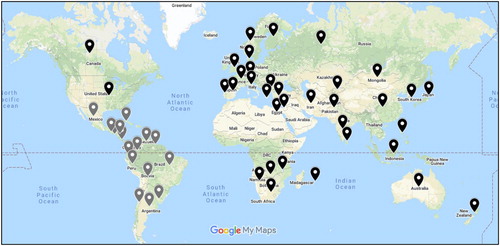Figures & data
Table 1. Numbers of questions focussing on different science levels in schools.
Figure 1. The distribution of countries with experts who took part in the survey. Latin American countries in pale grey. Annotated Google My Maps image.

Table 2. The 51 countries from which experts contributed to the UNESCO/IGEO international survey.
Table 3. Source of expertise of those completing the questionnaire (Global weighted %, n = 51; Non-Latin American %, n = 35; Latin American %, n = 16) (global weighted % = (non-LA % x 35/51) + (LA% x 16/51)).
Table 4. Earth science in the primary (elementary) science curriculum (global weighted % calculated).
Table 5. Earth science in the lower secondary (junior high) school science curriculum (global weighted % calculated).
Table 6. Learning methods used in lower school Earth science teaching (Global weighted %, n = 36; Non-Latin American %, n = 21; Latin American %, n = 15).
Table 7. Earth science in the upper secondary (high) school science curriculum (global weighted % calculated).
Table 8. Curriculum comparisons across pupil ages; data from tables 4–6 (n = 51).
Table 9. Earth science curriculum areas covered at each school level comprising more than 30% of the curriculum (global weighted % calculated).
Table 10. Countries with standardised assessment and those that include specific Earth science questions.
Table 11. The quality and provision of Earth science-teaching material available (N/A = not applicable) (Global = globally weighted (n = 51); Non-LA = non-Latin American (n = 35); LA = Latin American (n = 16)).
Table 12. Training and resourcing for teachers of Earth sciences (Global = globally weighted (n = 51); Non-LA = non-Latin American (n = 35); LA = Latin American (n = 16)).
Table 13. Levels of careers advice offered. (Global = globally weighted (n = 34); Non-LA = non-Latin American (n = 24); LA = Latin American (n = 10)).
Table 14. Regular nationwide events promoting Earth science (Global = globally weighted (n = 51); Non-LA = non-Latin American (n = 35); LA = Latin American (n = 16)).
Table 15. Impact of the Earth science education community.
Table 16. Provision of extra-curricular activities.
